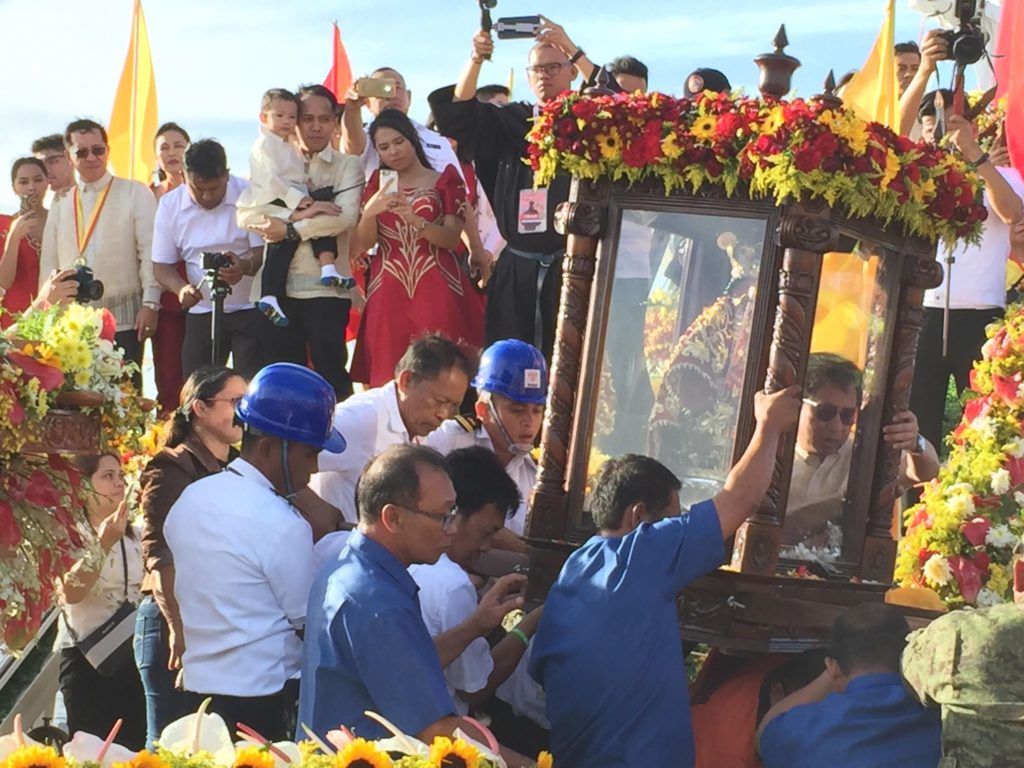1.5M devotees joined foot procession for Señor Sto. Niño; crowd 3 times bigger than last year

A multitude of devotees to the Señor Sto. Niño raised their hands in prayers, many holding small images of the Child Jesus, as the carroza carrying the Sto. Niño pass through the junction of Colon Street and Osmeña Boulevard in Cebu City during the afternoon solemn procession on Saturday, January 19, 2019, the eve of Fiesta Señor. |CDNDigital Photo by Tonee Despojo
CEBU CITY — Under overcast skies, hundreds of thousands of devotees lined the streets of Cebu City or joined the solemn procession traditionally held on the eve of the feast of the Sto. Niño de Cebu.
Senior Supt. Royina Garma, director of the Cebu City Police Office, said there were at least 1.5 million people who turned up for the prayer walk that snaked through the major streets of Cebu City for four hours.
The number was thrice higher than last year’s crowd of 500,000.
“All long, we were expecting more people to attend the religious activities this year. Since day 1 of the novena, we already noticed a thick crowd at the basilica,” Garma said.
Earlier in the day, several people also waited along the piers and shorelines in the cities of Mandaue, Lapu-Lapu and Cebu to take a glimpse of the fluvial procession — one of the highlights of the Fiesta Señor.
A total of 6,000 policemen and military personnel were deployed to secure the people during the religious activities.
Today, January 20, hundreds of thousands of pilgrims are expected to troop to the Basilica Minore del Sto. Niño to celebrate the feast of the Child Jesus. Cebu Archbishop Jose Palma will preside over a Pontifical Mass at 6 a.m. to be followed by eight other Masses at the Basilica’s Pilgrim Center.

Thousands of Sto. Niño devotees packed the junction of Osmeña Boulevard and Colon Street in Cebu City during the solemn foot procession on Saturday, January 19, 2019, the eve of Fiesta Señor (Feast of Child Jesus), which is more popularly known as the Sinulog Festival. |CDNDigital Photo by Tonee Despojo
Side by side with the church-led activities is the Sinulog grand parade and dance competition, which is expected to draw at least a million people.
Last year, the twin events drew to the Basilica and to the parade routes some 2 million people.
For this year’s Sinulog, there will only be 24 dancing contingents from Cebu and other provinces in the country, who will be competing in the Sinulog Festival.
But this year will also see a foreign dance troupe joining the grand parade for the first time. A guest contingent from the Wonju Dynamic Dancing Carnival based in Wonju, South Korea is expected to join the festival.
With only fewer contingents competing this year, Sinulog 2019 organizers are not only hoping for a peaceful and orderly street parade but for the event to end on time as well.
The grand parade this year will start at 9 a.m. along Imus Avenue and will end at around 6 p.m. at the Cebu City Sports Center (CCSC), where the announcement of winners and a musical-fireworks display will also be held. Last year’s festival had 30 competing contingents.
Drinking of alcoholic beverages along the Sinulog carousel route will be prohibited from 6 a.m. of January 20 (Sunday) until 6 a.m. of the next day (Monday, January 21).

Cebu City Mayor Tomas Osmeña, in a Facebook post on Saturday, January 19, 2019, warns unruly revelers that they will be detained in city-owned buses if they cause public disturbance in tomorrow’s Sinulog grand parade. | Screenshot from Osmena’s Facebook page
Cebu City Mayor Tomas Osmeña said anyone caught violating his directive will immediately be detained in temporary detention cells that the police will set up along the six-kilometer route.
“This will be the strictest Sinulog ever because there is a risk and because the trend shows that it is going to get worse (this year),” Osmeña said.
Osmeña said establishments located within the 300-meter radius of the grand parade route that will be caught violating his directive will also be closed.
Fr. Pacifico “Jun” Nohara Jr., rector of the centuries-old Basilica Minore del Sto. Niño, said the devotion to the Child Jesus has not dwindled even after centuries that the image of the Sto. Niño was given as baptismal gift by Portuguese explorer Ferdinand Magellan to Cebu’s Queen Juana.
“Our devotion to the Holy Child received a long time ago is a gesture of faith that we all cherish. And year after year, our celebration in honor of Señor Sto. Niño, our traditional Sinulog dances, our processions, our rituals and ceremonies, should make us grow in faith and love as well as make us witnesses of the Gospel and participants in the Church’s mission,” he said.
Cebu Archbishop Jose Palma carried the processional image of the Sto. Niño to the carroza to mark the start of the solemn procession.
Bells at the centuries-old church pealed as the carroza or carriage that bore the image of the Sto. Niño, escorted by priests, emerged from the Basilica’s courtyard at 1 p.m.
Devotees repeatedly shouted “Pit Senyor” and waved their hands up in the air when the ancient hymn for the Sto. Niño, “Batobalani sa Gugma,” was sung.
Another image of the Sto. Niño from San Nicolas Parish known as El Teniente dela Guardia was stationed in a carroza in front of the Basilica during the procession.
Traditionally, it guards the church while the Sto. Niño de Cebu is brought out for the procession. A human cord on composed of policemen, criminology interns, blue guards and college students under the National Service Training Program kept the throng of devotees at bay.
The procession passed by P. Burgos Street, Urdaneta Street, M.J. Cuenco Avenue, Imus Street, General Maxilom Avenue, Osmeña Boulevard, before returning to the Basilica.
There were no fireworks along the procession route following an appeal from the Augustinian priests in charge of the basilica to maintain the solemnity of the event and for public safety.
Balloons, however, continued to greet the Sto. Niño image despite the prohibition from Basilica although they were not as many as in previous years.
Some of the devotees threw confetti and flower petals to the flower-decked carroza of the Sto. Niño while others set up roadside altars, where they placed household images of the Sto. Niño.
Devotees waved their hands or uttered prayers as the Sto. Niño carroza decked with flowers.
Majority of those who joined the procession carried statues of the Sto. Niño, recited the Holy Rosary in English and Cebuano and sang liturgical hymns which were broadcast on radio and amplified by speakers installed along the procession route.
Also joining the solemn procession were the images of St. Joseph and the Our Lady of Consolation.
The carroza of the Sto. Niño returned to the Basilica at 5 p.m. and was greeted with applause and cheers by an overflowing crowd of devotees.
Palo Archbishop John Du then celebrated Mass at the Pilgrim Center, followed by an hour of joyous dancing for a litany of prayer intentions ranging from priests, parents, politicians, the sick, the youth, sinners and the loveless. Earlier yesterday, the images of the Sto. Niño and Our Lady of Guadalupe sailed down the Mactan Channel during the fluvial procession.

The glass-encased image of the Sto. Niño is being carried down from the ‘galleon’ following the fluvial parade on Jan. 19, 2019, the eve of the Fiesta Señor. | CDNDigital photo by Junjie Mendoza
A flotilla of 220 vessels, boarded by hundreds of individuals, accompanied the MV Super Joy of Roble Shipping Inc., which was chosen to to carry the Señor Santo Niño and Our Lady of Guadalupe images this year.
After the fluvial procession, the reenactment of the first Mass, baptism, and wedding in the Philippines was done at the Basilica’s outdoor Pilgrim Center.
Men dressed as Spanish soldiers planted beside the altar a huge, wooden cross with a white cloth to commemorate the arrival of Magellan and his men, and the birth of Catholicism in the Philippines.
After the Mass, the reenactment of the first baptism was done. Using a wooden ladle, Nohara sprinkled holy water on a group of “natives” as well as the couple who portrayed the role of Cebu’s pre-Spanish chieftain Rajah Humabon and his wife Humamay and a group of natives. Humabon got the baptismal name Carlos while his wife was named Juana.
Priests who concelebrated the Mass also blessed with holy water the crowd of about 3,000 devotees. After the Mass, Sinulog dances were performed by members of the Cofradia del Sto. Niño, Our Lady of Guadalupe, the late Estelita “Nang Titang” Diola’s dance group from Mabolo, and the San Diego Dance Troupe. /elb
Disclaimer: The comments uploaded on this site do not necessarily represent or reflect the views of management and owner of Cebudailynews. We reserve the right to exclude comments that we deem to be inconsistent with our editorial standards.
